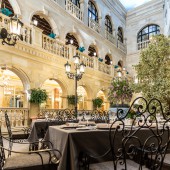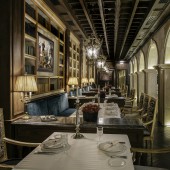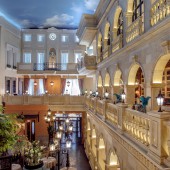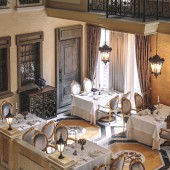
| THE AWARD |
| CATEGORIES |
| REGISTRATION |
| SUBMIT YOUR WORK |
| ENTRY INSTRUCTIONS |
| TERMS & CONDITIONS |
| PUBLICATIONS |
| DATES & FEES |
| METHODOLOGY |
| CONTACT |
| WINNERS |
| PRESS ROOM |
| GET INVOLVED |
| DESIGN PRIZE |
| DESIGN STORE |
| THE AWARD | JURY | CATEGORIES | REGISTRATION | PRESS | WINNERS | PUBLICATIONS | ENTRY INSTRUCTIONS |
Kalaki Fine Dining Restaurant by David Nikuradze |
Home > Winners > Design #76737 >Interview |
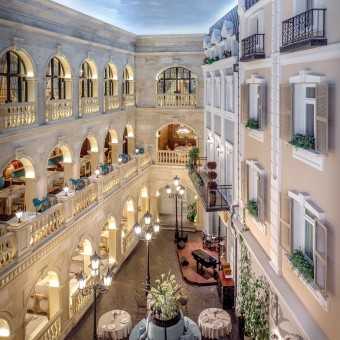 |
|
FS: What is the main principle, idea and inspiration behind your design?
DN: Located in one of the oldest neighborhoods in Tbilisi with diverse architectural styles and historical layers superimposing over 150 years of history, the architecture of the project was carefully considered and detailed for the contextual setting, with a quest to create a classic and sophisticated environment within the texture of the old town. The fundamental design concept of project surpasses the typical designation of a luxury restaurant and its main function, rather offers an unparalleled settings and meeting space where people experience and socialize in a magical atmosphere, what takes visitors away from city reality. The entire concept of the project revolves around main atrium, the heart of the restaurant, which resembles the typical inner yard of old Tbilisi residential neighborhoods where habitants meet, dine and socialize.
FS: What has been your main focus in designing this work? Especially what did you want to achieve?
DN: Our vision was to interpret the traditional function of the restaurant and extend it into a cultural and traditional synthesis of the different time zones and habits, creating unique spaces and environment enriched with the rich and textured local Georgian content superimposed with multifaceted cultural influences.
FS: What are your future plans for this award winning design?
DN: We are planning to furthermore promote the project, as it’s a very good example of what we do and how we approach the design process.
FS: How long did it take you to design this particular concept?
DN: Working on these designs from the research stage to final technical drawings took around 20 months to complete.
FS: Why did you design this particular concept? Was this design commissioned or did you decide to pursuit an inspiration?
DN: The overall concept was arrived together with Client with a brief to have a traditional Georgian inner yard concept tailored to different meeting and dining function. Along with our joint inspiration to have a vast, sophisticated space, taking visitors into time and space.
FS: Is your design being produced or used by another company, or do you plan to sell or lease the production rights or do you intent to produce your work yourself?
DN: The design was initially intended for the client’s use, who now operates as a very popular restaurant, which already became the ultimate must see destination place in the city. Any of our possible future works related to this project will be produced by us.
FS: What made you design this particular type of work?
DN: The overall context and feeling along with a very interesting idea seemed challenging for our team to undertake, especially where we had an opportunity to express ourselves and implement the concept, which had no analogs and a great potential to create a city landmark.
FS: Where there any other designs and/or designers that helped the influence the design of your work?
DN: Authentic Georgian culture with multicultural layers and history along with traditional inner yard design in Tbilisi were our main source of inspiration.
FS: Who is the target customer for his design?
DN: Anyone who is eager to escape from everyday urban routine in the place where time and space is insignificant, could be local city habitants, tourists and travelers, despite ethnicity culture or religion.
FS: What sets this design apart from other similar or resembling concepts?
DN: We believe it is a strong initial concept combined with rich Georgian history and multilayer cultural and social influences all under one roof.
FS: How did you come up with the name for this design? What does it mean?
DN: The name of the restaurant - Kalaki, in Georgian means CITY and the idea of space is to create a city within the city with a timeless atmosphere what enables visitors to travel in space, in history and culture and interpret the reality in different lens.
FS: Which design tools did you use when you were working on this project?
DN: The design tools used on this project vary from pencil sketches to modern, sophisticated architectural softwares for drawing and rendering such as Revit, AutoCadd, Cinema.
FS: What is the most unique aspect of your design?
DN: The city inside the city, where time is insignificant, where one can enjoy the magical atmosphere completely distracted from stressful urban routine. It’s the story told through interior styles, materials, lighting and historical context, which is deliberately imitated in the interior. The Atrium, artificial sky and outdoor facades used indoors add a certain theatrical nature to the space. Giving visitors the feeling of being part of ongoing theatrical performance. From its food and drinks to the furniture design, this place was designed to awaken feelings. There are multiple different dining halls, which allow to have different sensations, from more casual to luxurious dining experiences. Sol Omnia Lucet - the Latin caption at the entrance, translating sun shines for all, sums up the main idea of the project - creating the social gathering space functioned as a restaurant, where everybody finds their own individual space to experience a space in time.
FS: Who did you collaborate with for this design? Did you work with people with technical / specialized skills?
DN: During the design stage to construction we have collaborated several different disciplines of engineering along with historians, artists, musicians as well as constructions professionals and tradesman.
FS: What is the role of technology in this particular design?
DN: The challenge of creating acoustically best atmosphere that sound will be distributed evenly to all areas of the restaurant. Creating double layers of walls to completely block outdoor sound and have an internal mini acoustical climate in the space.
FS: Is your design influenced by data or analytical research in any way? What kind of research did you conduct for making this design?
DN: From the day one of the inception of the project we have collaborated with restaurant operators and have studied the current and upcoming restaurant market of very rich culture of fine dining in Tbilisi. We have done digital and personal research and have communicated with thousands of customers asking them for the ideal space the city was lacking. In the result of in-depth research and consideration, we have learned from different customers that highly interactive, dynamic space with different character dining experiences would be the ideal venue.
FS: What are some of the challenges you faced during the design/realization of your concept?
DN: The Design challenge presented was very strong historic context of the location. Surrounded by various architectural styles, from Tbilisi Renaissance to soviet architecture, the task was to create state of art, modern structure that would harmonically fit the environment and become undivided part of the urban context. Creating an interacting dining space that would utilize a very small building footprint and create vast and luxurious restaurant setting. One of the key challenges was creating the space, that would surpass the typical designation of a luxurious function of a restaurant, but would offer an unparalleled settings and meeting point where people would plan and spend their most important and memorable dates in a unique and magical atmosphere. Another challenge the designers faced was creating Different spaces for exclusive feelings. The hard decorative marble and mirror walls give a cold presence to the first floor dining area, while the soft brown colored textured ceiling, books and the wooden floor give warm romantic atmosphere on the second floor library hall. 100 years old pine right at the entrance of the building was another issue to deal with, we’ve decided to maintain the tree, to enjoy the natural conditions offered by location. Now this pine adds green glow to the restaurant façade.
FS: How did you decide to submit your design to an international design competition?
DN: As the result exceeded not only ours, but client’s and society’s expectations, we thought that the design deserved international recognition. We have decided to look for the competition, which would meet our requirements and provide an opportunity and international platform.
FS: What did you learn or how did you improve yourself during the designing of this work?
DN: Working on this project was very challenging, we faced some obstacles in designing stage and construction stage, which gave us a great experience and trust within our abilities to go further.
FS: Thank you for providing us with this opportunity to interview you.
A' Design Award and Competitions grants rights to press members and bloggers to use parts of this interview. This interview is provided as it is; DesignPRWire and A' Design Award and Competitions cannot be held responsible for the answers given by participating designers.
| SOCIAL |
| + Add to Likes / Favorites | Send to My Email | Comment | View Press-Release |
